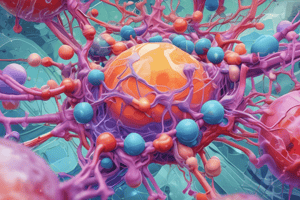Podcast
Questions and Answers
What is the definition of neoplasia?
What is the definition of neoplasia?
- The abnormal and controlled growth of cells
- The normal and uncontrolled growth of cells
- The normal and controlled growth of cells
- The abnormal and uncontrolled growth of cells (correct)
What is a characteristic of benign neoplasms?
What is a characteristic of benign neoplasms?
- They can only cause symptoms due to their size
- They are always fatal if left untreated
- They can invade surrounding tissues and metastasize
- They cannot invade surrounding tissues or metastasize (correct)
What is a characteristic of malignant neoplasms?
What is a characteristic of malignant neoplasms?
- They cannot invade surrounding tissues or metastasize
- They can invade surrounding tissues and metastasize (correct)
- They are always non-fatal if left untreated
- They can only cause symptoms due to their size
What is a characteristic of neoplastic cells?
What is a characteristic of neoplastic cells?
What is the multistep hypothesis?
What is the multistep hypothesis?
What is tumor initiation?
What is tumor initiation?
Flashcards are hidden until you start studying
Study Notes
Definition and Classification
- Neoplasia refers to the abnormal and uncontrolled growth of cells, leading to the formation of a neoplasm (tumor)
- Neoplasms can be benign (non-cancerous) or malignant (cancerous)
Types of Neoplasms
- Benign neoplasms:
- Typically do not invade surrounding tissues or metastasize
- Can still cause symptoms due to their size or location
- Examples: uterine fibroids, melanocytic nevus (moles)
- Malignant neoplasms (cancer):
- Can invade surrounding tissues and metastasize to distant sites
- Can be fatal if left untreated
- Examples: carcinoma, sarcoma, lymphoma, leukemia
Characteristics of Neoplastic Cells
- Loss of cellular regulation: Neoplastic cells ignore normal growth signals and continue to proliferate uncontrollably
- Genetic mutations: Neoplastic cells often have genetic abnormalities that contribute to their uncontrolled growth
- Dysregulation of apoptosis: Neoplastic cells may resist programmed cell death (apoptosis)
- Abnormal cell morphology: Neoplastic cells often exhibit altered size, shape, or structure
Neoplasm Development and Progression
- Multistep hypothesis: Neoplasia develops through a series of genetic mutations and epigenetic changes
- Tumor initiation: Initial mutation or exposure to carcinogen
- Tumor promotion: Stimuli that enhance neoplastic growth, such as hormones or growth factors
- Tumor progression: Neoplasm becomes more aggressive and invasive over time
Definition and Classification
- Neoplasia is the abnormal and uncontrolled growth of cells, resulting in a neoplasm (tumor)
- Neoplasms can be classified as either benign (non-cancerous) or malignant (cancerous)
Types of Neoplasms
- Benign Neoplasms
- Do not invade surrounding tissues or metastasize
- Can cause symptoms due to size or location
- Examples include uterine fibroids and melanocytic nevus (moles)
- Malignant Neoplasms (Cancer)
- Invade surrounding tissues and metastasize to distant sites
- Can be fatal if left untreated
- Examples include carcinoma, sarcoma, lymphoma, and leukemia
Characteristics of Neoplastic Cells
- Loss of Cellular Regulation: Neoplastic cells ignore normal growth signals and proliferate uncontrollably
- Genetic Mutations: Neoplastic cells often have genetic abnormalities contributing to uncontrolled growth
- Dysregulation of Apoptosis: Neoplastic cells resist programmed cell death (apoptosis)
- Abnormal Cell Morphology: Neoplastic cells exhibit altered size, shape, or structure
Neoplasm Development and Progression
- Multistep Hypothesis: Neoplasia develops through a series of genetic mutations and epigenetic changes
- Tumor Initiation: Initial mutation or exposure to carcinogen
- Tumor Promotion: Stimuli enhancing neoplastic growth, such as hormones or growth factors
- Tumor Progression: Neoplasm becomes more aggressive and invasive over time
Studying That Suits You
Use AI to generate personalized quizzes and flashcards to suit your learning preferences.




